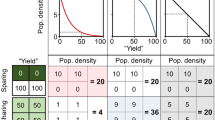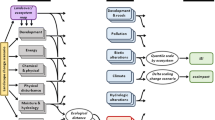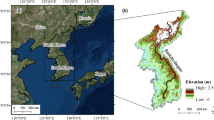Abstract
Context
The acceleration of infrastructure development presents many challenges for the mitigation of ecological impacts. The type, extent, and cumulative effects of multiple developments must be quantified to enable mitigation.
Objectives
We quantified anthropogenic development footprints in a globally significant and relatively intact region. We identified the proportion accounted for by linear infrastructure (e.g. roads) including infrastructure that is currently unmapped; investigated the importance of key landscape drivers; and explored potential ramifications of offsite impacts (edge effects).
Methods
We quantified direct development footprints of linear and ‘hub’ infrastructure in the Great Western Woodlands (GWW) in south-western Australia, using digitisation and extrapolation from a stratified random sample of aerial imagery. We used spatial datasets and literature resources to identify predictors of development footprint extent and calculate hypothetical ‘edge effect zones’.
Results
Unmapped linear infrastructure, only detectable through manual digitisation, accounts for the greatest proportion of the direct development footprint. Across the 160,000 km2 GWW, the estimated development footprint is 690 km2, of which 67% consists of linear infrastructure and the remainder is ‘hub’ infrastructure. An estimated 150,000 km of linear infrastructure exists in the study area, equating to an average of ~1 km per km2. Beyond the direct footprint, a further 4000–55,000 km2 (3–35% of the region) lies within edge effect zones.
Conclusions
This study highlights the pervasiveness of linear infrastructure and hence the importance of managing its cumulative impacts as a key component of landscape conservation. Our methodology can be applied to other relatively intact landscapes worldwide.






Similar content being viewed by others
References
Abood SA, Lee JSH, Burivalova Z, Garcia-Ulloa J, Koh LP (2014) Relative contributions of the logging, fiber, oil palm and mining industries to forest loss in Indonesia. Conserv Lett 8(1):58–67
Ahmed SE, Souza CM Jr, Riberio J, Ewers RM (2013) Temporal patterns of road network development in the Brazilian Amazon. Regional Environ Change 13(5):927–937
Bates D, Mächler M, Bolker B, Walker S (2015) Fitting Linear Mixed-Effects Models Using lme4. J Stat Softw 67(1)
Barton K (2015) MuMIn: Multi-Model Inference. R package version 1.15.1
Baynard CW (2011) The landscape infrastructure footprint of oil development: Venezuela’s heavy oil belt. Ecol Indicators 11(3):789–810
Bernath-Plaisted J, Koper N (2016) Physical footprint of oil and gas infrastructure, not anthropogenic noise, reduces nesting success of some grassland songbirds. Biol Conserv 204:434–441
Berry S, Keith H, Mackey B, Brookhouse M, Jonson J (2010) Green carbon: the role of natural forests in carbon storage. Part 2. Biomass carbon stocks in the Great Western Woodlands. The Fenner School of Environment and Society, Australian National University E Press, Canberra, Australia
Beyer HL, Gurarie E, Borger L, Panzacchi M, Basille M, Herfindal I, Van Moorter B, Lele RA, Matthiopoulos J (2014) You shall not pass!: quantifying barrier permeability and proximity avoidance by animals. J Animal Ecol 85(1):43–53
Booth C, Traill B (2008) Conservation of Australia’s outback wilderness. Pew Environment Group & The Nature Conservancy. Wild Australia Program, Sydney
Boyd DS, Foody GM (2011) An overview of recent remote sensing and GIS based research in ecological informatics. Ecol Inform 6(1):25–36
Canter L, Ross B (2010) State of practice of cumulative effects assessment and management: the good, the bad and the ugly. Impact Assess Proj Apprais 28(4):261–268
Caro TIM, Darwin J, Forrester T, Ledoux-Bloom C, Wells C (2012) Conservation in the Anthropocene. Conserv Biol 26(1):185–188
Carranza T, Balmford A, Kapos V, Manica A (2014) Protected area effectiveness in reducing conversion in a rapidly vanishing ecosystem: the Brazilian Cerrado. Conserv Lett 7(3):216–223
Core Team R (2015) R: a language and environment for statistical computing. R Foundation for Statistical Computing, Vienna
Department of Environment and Conservation (2010) A biodiversity and cultural conservation strategy for the Great Western Woodlands. Government of Western Australia
Department of Mines and Petroleum (2013) Prospecting, exploration and mining on pastoral leases. Government of Western Australia, Perth, pp 1–6
Department of Mines and Petroleum (2015) Record spike in mining and exploration applications for June/July. Environment eNewsletter, 15th edn. Government of Western Australia, Perth, p 12
Elmes A, Ipanaque JGY, Rogan J, Cuba N, Bebbington A (2014) Mapping licit and illicit mining activity in the Madre de Dios region of Peru. Remote Sens Lett 5(10):882–891
Evans MC, Tulloch AI, Law EA, Raiter KG, Possingham HP, Wilson KA (2015) Clear consideration of costs, condition and conservation benefits yields better planning outcomes. Biol Conserv 191:716–727
Ferraz A, Mallet C, Chehata N (2016) Large-scale road detection in forested mountainous areas using airborne topographic lidar data. Isprs J Photogrammetry Remote Sens 112:23–36
Finer M, Jenkins CN, Pimm SL, Keane B, Ross C (2008) Oil and gas projects in the Western amazon: threats to wilderness, biodiversity, and indigenous peoples. PLoS ONE 3(8):e2932
Finer M, Jenkins CN, Powers B (2013) Potential of best practice to reduce impacts from oil and Gas projects in the Amazon. PLoS ONE 8(5):e63022
Forman RTT, Sperling D, Bissonette JA, Clevenger AP, Cutshall CD (2003) Road ecology: science and solutions. Island Press, Washington
Fraser B (2014) Deforestation: carving up the Amazon. Nature 509:418–419
Freudenberger L, Hobson PR, Rupic S, Pe’er G, Schluck M, Sauermann J, Kreft S, Selva N, Ibisch PL (2013) Spatial road disturbance index (SPROADI) for conservation planning: a novel landscape index, demonstrated for the State of Brandenburg. Germany. Landscape Ecol 28(7):1353–1369
Goosem M (2007) Fragmentation impacts caused by roads through rainforests. Curr Sci 93(11):1587
Goosem M (2012) Mitigating the impacts of rainforest roads in Queensland’s Wet Tropics: effective or are further evaluations and new mitigation strategies required? Ecol Manag Restor 13(3):254–258
Gosper CR, Prober SM, Yates CJ, Scott JK (2015) Combining asset-and species-led alien plant management priorities in the world’s most intact Mediterranean-climate landscape. Biodivers Conserv 24(11):2789–2807
Hawbaker TJ, Radeloff VC (2004) Roads and landscape pattern in northern Wisconsin based on a comparison of four road data sources. Conserv Biol 18(5):1233–1244
Jaeger JAG (2015) Improving environmental impact assessment and road planning at the landscape scale. In: van der Ree R, Smith DJ, Grilo C (eds) Handbook of Road Ecology. Wiley, Chichester, UK, pp 32–42
Johnson CJ, Boyce MS, Case RL, Cluff HD, Gau RJ, Gunn A, Mulders R (2005) Cumulative effects of human developments on arctic wildlife. Wildl Monogr 160:1–36
Jones IL, Bull JW, Milner-Gulland EJ, Esipov AV, Suttle KB (2014) Quantifying habitat impacts of natural gas infrastructure to facilitate biodiversity offsetting. Ecol Evol 4(1):79–90
Judd S, Watson JEM, Watson AWT (2008) Diversity of a semi-arid, intact Mediterranean ecosystem in southwest Australia. Web Ecol 8:84–93
Karlson M, Mortberg U (2015) A spatial ecological assessment of fragmentation and disturbance effects of the Swedish road network. Landsc Urban Plan 134:53–65
Laurance WF, Goosem M (2008) Impacts of habitat fragmentation and linear clearings on Australian rainforest biota. In: Stork NE, Turton SM (eds) Living in a dynamic tropical forest landscape. Blackwell Publishing, Malden, pp 295–306
Laurance WF, Peletier-Jellema A, Geenen B, Koster H, Verweij P, Van Dijck P, Lovejoy TE, Schleicher J, Van Kuijk M (2015) Reducing the global environmental impacts of rapid infrastructure expansion. Curr Biol 25(7):R259–R262
Lister N-M, Brocki M, Ament R (2015) Integrated adaptive design for wildlife movement under climate change. Front Ecol Environ 13(9):493–502
Liu S, Cui B, Dong S, Yang Z, Yang M, Holt K (2008) Evaluating the influence of road networks on landscape and regional ecological risk–A case study in Lancang River Valley of Southwest China. Ecol Eng 34(2):91–99
Mjachina KV, Baynard CW, Chibilyev AA (2014) Oil and gas development in the Orenburg region of the Volga-Ural steppe zone: qualifying and quantifying disturbance regimes. Int J Sustain Dev World Ecol 21(2):111–126
Nellemann C, Cameron R (1998) Cumulative impacts of an evolving oil-field complex on the distribution of calving caribou. Can J Zool 76(8):1425–1430
Pinheiro J, Bates D, DebRoy S, Sarkar D, R Core Team (2017) nlme: Linear and Nonlinear Mixed Effects Models. R package version 3.1–131. https://CRAN.R-project.org/package=nlme
Prober SM, Thiele KR, Rundel PW, Yates CJ, Berry SL, Byrne M, Christidis L, Gosper CR, Grierson PF, Lemson K, Lyons T (2012) Facilitating adaptation of biodiversity to climate change: a conceptual framework applied to the world’s largest Mediterranean-climate woodland. Climatic Change 110(1):227–248
Raiter KG, Possingham HP, Prober SM, Hobbs RJ (2014) Under the radar: mitigating enigmatic ecological impacts. Trends Ecol Evol 29(11):635–644
Raiter KG (2017) Spatial analysis data for ‘Lines in the sand: quantifying the cumulative development footprint in the world’s largest remaining temperate woodland’. AEKOS - TERN Ecoinformatics. https://doi.org/10.4227/05/59893d248decc
Roche C, Mudd G (2014) An overview of mining and the environment in Western Australia. In: Brueckner M, Durey A, Mayes R, Pforr C (eds) Resource curse or cure?, CSR, sustainability, ethics & governance. Springer, Berlin, pp 179–194
Runge CA, Tulloch AIT, Gordon A, Rhodes JR (2017) Quantifying the conservation gains from shared access to linear infrastructure. Conserv Biol Accepted Author Manuscript
Schneider R, Dyer S (2006) Death by A Thousand Cuts: The Impacts of In Situ Oil Sands Development on Alberta’s Boreal Forest. Oil Sands Fever Series, 1st Edition edn. Canadian Parks and Wilderness Society and The Pembina Institute, Edmonton, p. 50
Seiferling I, Proulx R, Wirth C (2014) Disentangling the environmental heterogeneity—species diversity relationship along a gradient of human footprint. Ecology 95(8):2084–2095
Suring LH, Barber KR, Schwartz CC, Bailey TN, Shuster WC, Tetreau MD (1998) Analysis of cumulative effects on brown bears on the Kenai Peninsula, Southcentral Alaska. Ursus 10:107–117
The Chamber of Mineral and Energy, Association of Mining and Exploration Companies, The Pastoralists and Graziers Association of W.A. (1999) Code of conduct for mineral exploration on pastoral leases. Perth, Australia, pp. 1–10
Therivel R, Ross B (2007) Cumulative effects assessment: does scale matter? Environ Impact Asses 27(5):365–385
Tyler NJ, Stokkan KA, Hogg CR, Nellemann C, Vistnes AI (2016) Cryptic impact: visual detection of corona light and avoidance of power lines by reindeer. Wildl Soc Bull 40(1):50–58
Underwood EC, Klausmeyer KR, Cox RL, Busby SM, Morrison SA, Shaw MR (2009) Expanding the global network of protected areas to save the imperiled Mediterranean biome. Conserv Biol 23(1):43–52
van der Ree R, Smith DJ, Grilo C (2015a) The ecological effects of linear infrastructure and traffic. In: van der Ree R, Smith DJ, Grilo C (eds) Handbook of Road Ecology. Wiley, Chichester, UK, pp 1–9
van der Ree R, Smith DJ, Grilo C (eds) (2015b) Handbook of Road Ecology. JWiley, Chichester, UK
van Etten EJB (2013) Changes to land tenure and pastoral lease ownership in Western Australia’s central rangelands: implications for co-operative, landscape-scale management. Rangel J 35(1):37–46
Watson A, Judd S, Watson J, Lam A, Mackenzie D (2008) The extraordinary nature of the Great Western Woodlands. The Wilderness Society, Perth
Westcott F, Andrew ME (2015) Spatial and environmental patterns of off-road vehicle recreation in a semi-arid woodland. Appl Geogr 62:97–106
Wood EM, Pidgeon AM, Radeloff VC, Helmers D, Culbert PD, Keuler NS, Flather CH (2014) Housing development erodes avian community structure in U.S. protected areas. Ecol Appl 24(6):1445–1462
Acknowledgements
We gratefully acknowledge support from the Gledden Postgraduate Research Scholarship, the Australian Research Council Centre of Excellence for Environmental Decisions, The Wilderness Society, Gondwana Link, the Natural Environmental Research Program Environmental Decisions Hub, and the Great Western Woodlands Supersite, part of Australia’s Terrestrial Ecosystem Research Network. We thank Ophir Levin, Julia Waite, Brad Desmond, and Rachel Omodei for assistance in digitising the unmapped development footprint. We also thank Fiona Westcott for her assistance in ground-truthing, Cliffs Natural Resources for in-kind support in the field, and Amanda Keesing (Gondwana Link), Judith Harvey (DPaW) and Katherine Zdunic (DPaW) for their assistance in supplying spatial information. Ashley Sparrow, Richard Forman, Andrew Bennett, John Bissonette, and two anonymous reviewers provided valuable reviews that improved this manuscript. All fieldwork was carried out under Department of Parks and Wildlife Regulation 4 lawful authority CE003548.
Author information
Authors and Affiliations
Corresponding author
Electronic supplementary material
Below is the link to the electronic supplementary material.
Rights and permissions
About this article
Cite this article
Raiter, K.G., Prober, S.M., Hobbs, R.J. et al. Lines in the sand: quantifying the cumulative development footprint in the world’s largest remaining temperate woodland. Landscape Ecol 32, 1969–1986 (2017). https://doi.org/10.1007/s10980-017-0558-z
Received:
Accepted:
Published:
Issue Date:
DOI: https://doi.org/10.1007/s10980-017-0558-z




